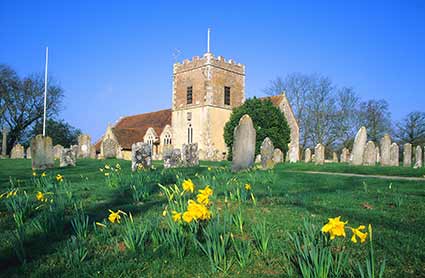New Forest parish churches -
places for worship and of history

Appreciate the atmosphere and soak up the history associated with many fine old parish churches scattered around the New Forest. Saxon work from more than 1,000 years ago is visible in some, whilst many exhibit features incorporated by Norman builders not long after the Conquest in 1066.
Virtually all, too, show evidence of additions, modifications and rebuilding in later centuries, changes necessary to renew crumbling stonework, reflect changing fashions and accommodate increasing congregations.
But whatever the age of these magnificent structures, a timeless magic lingers within their hallowed walls, emphasised by the music of ancient bells and the ticking of the church clock.
Countless generations of local people, New Forest folk whose world was significantly different from that of today, have worshipped within and found final resting places nearby in aged churchyards. Indeed, all these wonderful parish churches have marvellous stories to tell that can be experienced by those with ears to hear, a little imagination and a huge sense of reverence.
Brockenhurst parish church (A), for example, dedicated to St Nicholas, contains stonework placed by Saxon builders, and the structure of Boldre parish church (B) can be traced back to the 11th century.
Beaulieu parish church (C) was originally part of the earlier Cistercian Abbey on the same site, whilst St. Michael and All Angels, Lyndhurst (D), is a fine example of Victorian architecture standing on the site of an earlier Georgian church.
All Saints, Minstead (E) is a charming mixture of styles. Part of the font, considered to be of Saxon date, is said to be the oldest stone in the building that can be positively dated, whilst the arched doorway into the church from the north porch and the chancel arch are from the 12th or 13th centuries. The north porch dates from the 17th century and so does the unusual three-decker pulpit. The tower, and lower gallery - provided to accommodate the musicians who invariably accompanied the singing of hymns - are from the late 18th century, and the upper gallery, added to provide space and seating for local schoolchildren and the poor of the parish, from the early 19th century.
A little to the north of Minstead, the Church of St Peter, Bramshaw (F), dates back in part to the 13th century, although much of the structure was rebuilt in brick in the early 19th century. Eling parish church (G), a little outside the New Forest perambulation, close to Southampton Water, is dedicated to St Mary the Virgin and can trace its ancestry back to the 9th century, although the current building dates to the days of the Normans - perhaps the 11th century. Here, subsequent alterations from the 12th century onwards are much in evidence.
At Lymington, the Parish Church of St. Thomas (H) was originally constructed in around 1250, but repeated rebuilds and restorations have resulted in a charming structure of mixed ages and styles. (The distinctive tower and cupola, for example, are believed to be additions from the second half of the 17th century). Similarly, at Milford-on-Sea's All Saints Church (I) there is evidence of Norman, Early English, Decorated and Perpendicular architecture.
A little farther afield, outside the New Forest boundary in the Avon Valley at Downton, the Parish Church of St Lawrence (J), situated on the eastern side of the village, dates back to the mid-12th century, although later additions and the results of substantial mid-17th century restoration and rebuilding are evident; and at nearby Breamore (K), the parish church, dedicated to St Mary, is of Saxon origin - the walls are in-filled with uncut flints gathered from the fields, whilst Saxon lettering is still visible on an arch under the tower.
Further south in the Avon valley, at Fordingbridge, the largely Norman church of St. Mary the Virgin (L) has in its porch a large wooden notice commemorating the 17th century establishment of the 'Sandy Balls Charity'; at Harbridge's Church of All Saints (M) the tower is of the 15th century but the remainder of the structure was rebuilt in 1840; and at Ellingham, a tiny hamlet two kilometres down-stream from Harbridge, the Parish Church of St. Mary and All Saints (N) is perhaps best known as the last resting place of Dame Alice Lisle of nearby Moyles Court, infamously beheaded in September 1685 at Winchester for sheltering two men at her home after the Battle of Sedgemoor.
Ringwood parish church (O), dedicated to St. Peter and St. Paul, was constructed between 1853 and 1855, but on the site of earlier church buildings dating from at least 11th century. And finally, perhaps most imposing of all is Christchurch Priory (P). Situated close to the mouth of the River Avon, it was an Augustinian Priory from 1094 until the dissolution of the Monasteries in 1539, and has been a parish church ever since.
Quick linksMore links
Search this site

Sadly, 58 animals were killed - 35 ponies, 13 cows, 8 donkeys and 2 sheep, whilst a further 32 were injured - 3 pigs, 9 donkeys, 11 cows and 9 ponies.
(Forty-three accidents occurred in daylight, 15 at twilight and 101 in the dark. Twenty-seven accidents were not reported by the driver involved).
Here's just one horrific example - Three donkeys killed in collision with van at notorious New Forest blackspot (Advertiser and Times)

